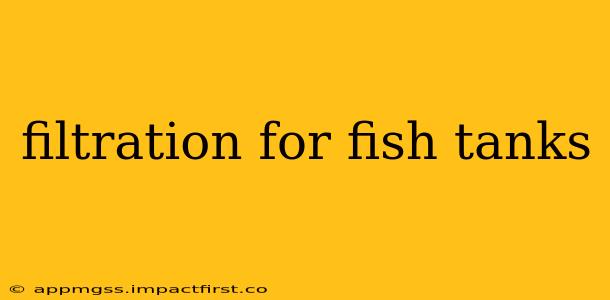Keeping a healthy and thriving fish tank hinges on effective filtration. A clean aquarium isn't just aesthetically pleasing; it's crucial for the well-being of your aquatic inhabitants. This comprehensive guide explores the various types of fish tank filtration, their benefits, and how to choose the right system for your specific needs.
What are the Different Types of Fish Tank Filters?
Several filter types dominate the aquarium market, each with unique strengths and weaknesses:
-
Undergravel Filters (UGF): These filters rely on an air pump to draw water through a porous plate beneath the gravel. Beneficial bacteria colonize the gravel, aiding in biological filtration. While cost-effective, UGFs are less efficient than other filter types and can be challenging to clean effectively. They're often considered outdated by many experienced aquarists.
-
Hang-on-Back (HOB) Filters: Extremely popular due to their ease of installation and affordability, HOB filters hang on the back of the tank. They typically incorporate mechanical, biological, and chemical filtration stages. Their compact design makes them suitable for smaller to medium-sized aquariums.
-
Canister Filters: These powerful external filters are considered the gold standard by many aquarists. They offer superior filtration capacity, handling large volumes of water efficiently. They feature multiple filter media stages (mechanical, biological, and chemical) and are ideal for larger tanks and those housing more demanding fish species. They require more initial setup but offer excellent long-term performance.
-
Internal Filters: Compact and easy to install within the tank itself, internal filters are a good option for smaller tanks. They're generally less powerful than canister or HOB filters but offer adequate filtration for smaller setups. They’re also quieter than many other filter types.
-
Sponge Filters: These simple, low-maintenance filters are best suited for smaller tanks, breeding tanks, or tanks with sensitive inhabitants. They rely primarily on biological filtration, providing a gentle water flow. They are excellent at supporting beneficial bacteria colonies.
What is the Best Type of Filter for My Fish Tank?
The ideal filter depends entirely on your tank size, the number and type of fish, and your budget.
-
Small tanks (under 20 gallons): Sponge filters or internal filters often suffice.
-
Medium tanks (20-55 gallons): HOB filters are a popular and generally effective choice.
-
Large tanks (55 gallons and above): Canister filters are typically recommended for their superior filtration capacity and efficiency.
How Often Should I Clean My Fish Tank Filter?
Over-cleaning your filter can disrupt the beneficial bacteria colonies crucial for biological filtration. A good rule of thumb is to clean the mechanical filter media (e.g., filter sponges) every 2-4 weeks, rinsing them gently in old aquarium water to avoid harming the bacteria. Replace chemical filter media (e.g., activated carbon) as directed by the manufacturer. Biological media (e.g., ceramic rings or bio-balls) should rarely need cleaning, and only when visibly clogged.
What are the Different Types of Filter Media?
Fish tank filters utilize various media types to achieve mechanical, biological, and chemical filtration:
-
Mechanical Filtration: Removes large debris such as fish waste, uneaten food, and other particulate matter. Examples include filter floss, filter sponges, and filter pads.
-
Biological Filtration: Houses beneficial bacteria that break down harmful ammonia and nitrite into less toxic nitrate. Examples include ceramic rings, bio-balls, and lava rock.
-
Chemical Filtration: Removes unwanted substances from the water, such as chlorine, chloramine, and certain medications. Examples include activated carbon and resin.
What is the Importance of Biological Filtration?
Biological filtration is arguably the most critical aspect of aquarium filtration. Beneficial bacteria (Nitrosomonas and Nitrobacter) convert toxic ammonia and nitrite produced by fish waste and uneaten food into less harmful nitrate, which can then be removed through water changes. Without sufficient biological filtration, ammonia and nitrite buildup can quickly poison your fish.
How Do I Choose the Right Filter Media for My Tank?
The best combination of filter media depends on your specific needs. Most filter systems include a mix of mechanical, biological, and chemical media. Consider adding more biological media if you have a high bioload (many fish or very active fish). Replace activated carbon after a few weeks, as it becomes saturated.
This comprehensive guide should help you understand the intricacies of fish tank filtration and select the optimal system for your aquarium. Remember, a well-maintained filtration system is vital for the health and longevity of your fish.
